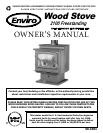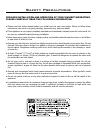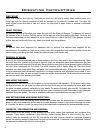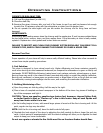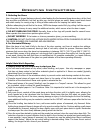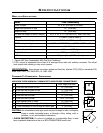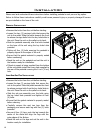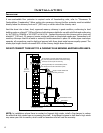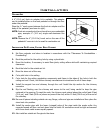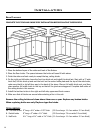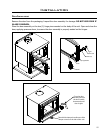
7
Operating Instructions
2. What type of wood is best to use as rewood?
Both hardwood and softwood burn well in this stove. Both woods contain about 8,000 BTU/lb (18,570
KJ/Kg), but hardwood is generally denser, will weigh more per cord, and burns a little slower and longer.
Cutting rewood so that it will t horizontally, front to back, makes it easier loading and less likely for
the fuel to roll on the glass. Except for a cold start, there is no need to crisis-cross the logs. Ideal length
would be about 18“ (3457 mm) for the 2100. Burn only dry, seasoned wood. It produces more heat and
less soot or creosote. Freshly cut wood has about 50% moisture. A 10 pound (4.5 Kg) log contains 5
pound (2.3 Kg) of water. To season rewood split and stack it so that air can get to all parts of the wood.
Burn beach wood only if its salt content has been washed away in a season of rain and then the wood
dried. To prevent smoke spillage, when refueling, open the door slowly.
3. What does dry, seasoned wood mean?
Wood that has been dried for a period of one year in a well-ventilated and sheltered area would be
considered dry, seasoned wood. Wood from slow-growing trees is generally considered better than
wood from fast-growing trees. To season rewood split and stack it so that air can get to all parts of the
wood.
4. Will following the above-listed steps for starting a re mean perfect results every time?
The quick answer is ‘most of the time’. There are many variables that may affect your success when
starting a re. Most of those variables and how to deal with them will be learned through experience.
Your ability to start a good re will signicantly increase with time and patience. Some of the reasons for
poor stove performance will be covered in the next section of these instructions.
5. Why can’t I get the re lit?
Damp or wet wood and poor drafts are the main reasons for poor results in starting a re. Always use
dry, seasoned wood for your re. Even wood dried for two years will be difcult to ignite if it has become
wet.
6. Is it normal for soot to cover the glass at the beginning of a re?
Your stove has been built with an air-wash system that will help keep the glass clear when the rebox
has reached a good operating temperature and has a good draft. Normally a hot stove will keep the glass
clean, but if you must clean the glass, use a soft cloth with no abrasive and clean only when cold. Cold
rebox temperature and poor draft cause sooting of the glass. Once the rebox temperature and the
draft increase, the soot will burn off.
7. What is draft?
Draft is the ability of the chimney to exhaust or draw smoke produced during the normal combustion
process. Too much draft may cause excessive temperatures in the appliance and may damage the
appliance*. Inadequate draft may cause backpufng or “plugging” of the chimney. There is a certain
amount of draft that is required to allow for your stove to function at its’ highest efciency. A water
column gauge can be used to reference this amount.



